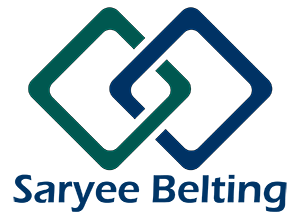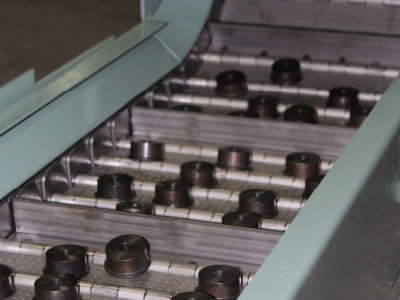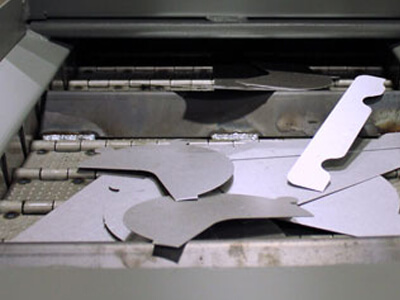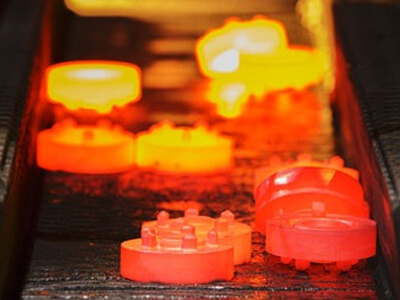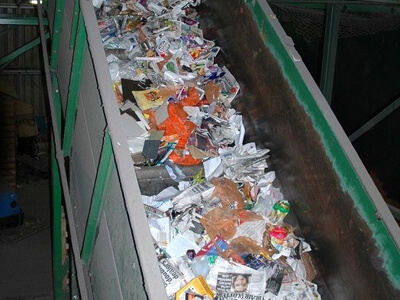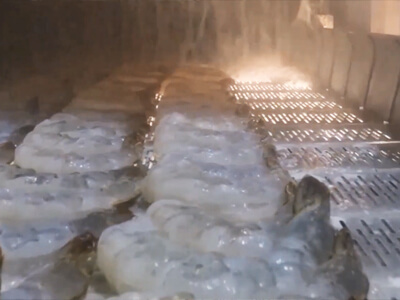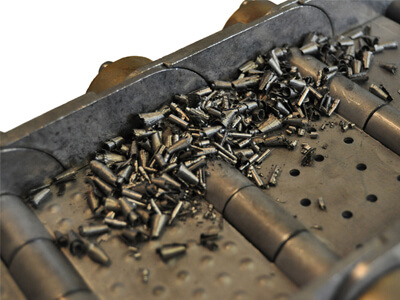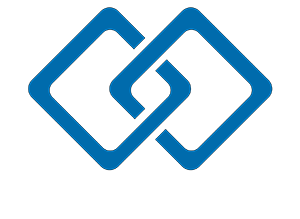Plate link conveyor belts
HOME / PRODUCTS / Metal Conveyor Belts / Plate Link Conveyor Belts
High-Strength and High-Load-Bearing Plate Link Conveyor Belts Customization Available
Plate link conveyor belts include chip conveyor belts, steel hinge conveyor belts, apron pan conveyor belts and other steel slat conveyor belts.
The Plate Link belt is known for its robust design and high load capacity, making it well-suited for demanding engineering processes like presswork, die-casting, and forging. These belts are designed to withstand heavy loads and harsh conditions, which makes them suitable for industrial applications where durability and strength are crucial.
Belts Specification
| Material | Carbon steel , SUS201 , SUS304 , SUS316 |
| Rod pitch | 19.05mm, 25.4mm, 31.75mm, 38.1mm, 50.8mm, 76.2mm, 100.00mm, 152.4 mm |
| Rod diameter | 5mm, 6mm, 8mm, 10mm, 12mm |
| Plate thickness | 0.8mm, 1mm, 1.2mm, 1.5mm, 2mm, 2.5mm, 3mm |
| Belt width | 200- 4000 mm |
| Working temperature | up to 450°C |
Belt Types
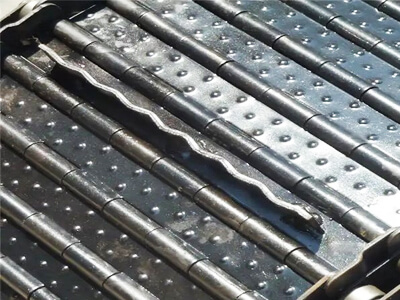

Chip Conveyor Belts
Chip conveyor belts are designed for handling metal chips and similar materials produced during machining processes, such as in metalworking industries. The design allows for efficient chip removal from machines to a collection area.
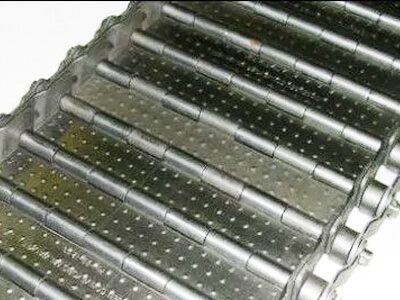

Steel Hinge Conveyor Belts
Steel Hinge Conveyor Belts, made of metal plates connected by steel hinges, offer a robust solution for heavy-duty applications. They are commonly used in industries where durability and strength are essential, such as in the transportation of heavy or sharp-edged materials.
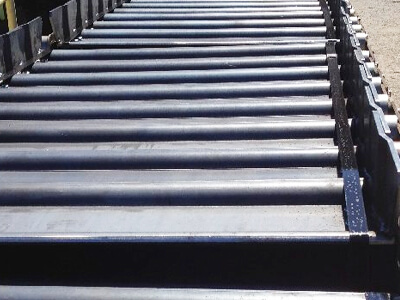

Apron Pan Conveyor Belts
Apron pan conveyor belts feature metal plates or pans that are interconnected to form a continuous belt. They are suitable for applications requiring durability and the ability to handle heavy loads, such as in mining or bulk material handling.
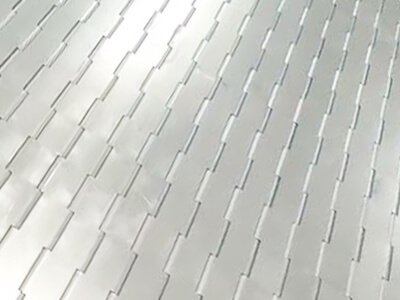

Plate Link Conveyor Belts without Perforations
Slats without perforations provide a continuous and smooth surface. This can be beneficial for conveying materials that require an even and uninterrupted support, preventing any protrusions or irregularities that may affect the transported items.
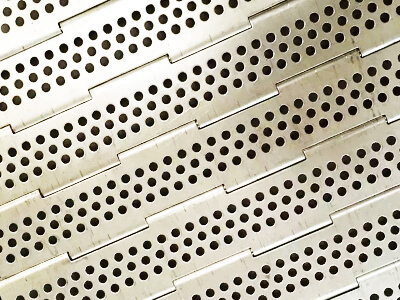

Plate Link Conveyor Belts with Perforations
Link plate belts featuring perforated slats offer tailored advantages for specific industrial applications. These benefits include effective drainage, crucial for industries with wet processes or cleaning operations; enhanced air circulation, beneficial in drying or cooling applications; reduced overall belt weight, advantageous for portable or mobile conveyor system. Choosing between perforated and non-perforated link plate belts depends on factors such as material type, operational environment, and desired functionalities, ensuring optimal performance for diverse conveyor system needs.
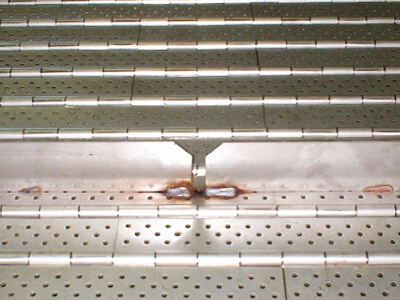

Plate Link Conveyor Belts with Flights
Plate link conveyor belts with flights incorporate additional features known as flights, which are raised elements attached to the surface of the belt at regular intervals. Flights on the plate link conveyor belt help to contain and control the movement of materials. They prevent items from sliding or falling off the sides of the belt, especially when the conveyor is inclined. Plate link conveyor belts with flights can be designed to facilitate sorting and separation of materials. The flights help create distinct channels or sections on the belt, allowing for organized material handling.
Belts Edge Availability
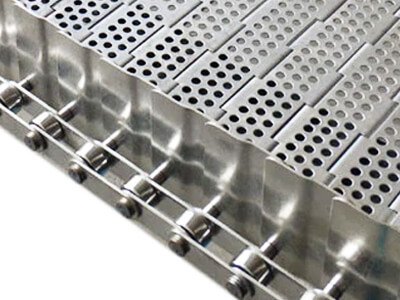

Plate Link Conveyor Belts with Guard Edge
Plate link conveyor belts with guard edges are designed to incorporate protective elements along the edges of the belt, often referred to as guard edges. The guard edges prevent materials from spilling over the sides of the conveyor belt. The design and dimensions of the guard edges can be customized to suit specific application requirements. This allows for flexibility in adapting the conveyor system to different materials and operational needs.
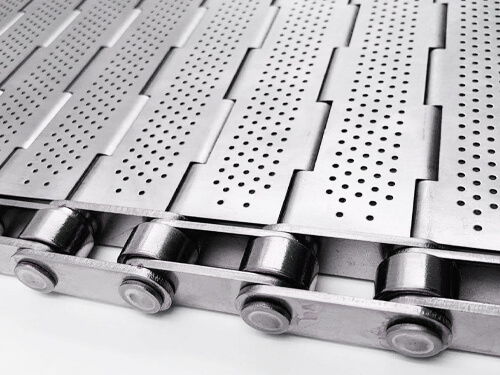

Plate Link Conveyor Belts without Guard Edge
Plate link conveyor belts without guard edges are designed without additional protective elements along the edges of the belt. In contrast to belts with guard edges, those without this feature have a more open and exposed edge configuration. Belts without guard edges are often simpler in design, which can result in easier maintenance and cleaning. There are fewer components to manage, making the conveyor system straightforward.
Common Specifications of plate link Conveyor Belts


| Description | Pitch (mm) | Slat Thickness (mm) | Roller Diameter (mm) | Rod Diameter (mm) | Chain Width (mm) |
| Light Duty | 31.75 | 1.5 & 2 | 25.4 | 6.35 or 9.53 | 25.4 |
| Light Duty | 38.1 | 1.5 & 2 | 25.4 | 6.35 or 9.53 | 25.4 |
| Light Duty | 38.1 | 1.5 & 2 | 25.4 | 6.35 | 25.4 |
| Light Duty | 50.8 | 1.5 & 2 | 25.4 | 6.35 | 25.4 |
| Light Duty | 76.2 | 1.5 & 2 | 25.4 | 6.35 | 25.4 |
| Medium Duty | 38.1 | 3 | 25.4 | 9.53 | 25.4 |
| Medium Duty | 50.8 | 3 | 25.4 | 9.53 | 25.4 |
| Medium Duty | 76.2 | 3 | 25.4 | 9.53 | 25.4 |
| Medium Duty | 101.6 | 3 | 25.4 | 9.53 | 25.4 |
| Medium Duty | 152.4 | 3 | 25.4 | 9.53 | 25.4 |
| Medium Duty | 50.8 | 3 | 31.8 | 9.53 | 31.8 |
| Medium Duty | 76.2 | 3 | 31.8 | 9.53 | 31.8 |
| Medium Duty | 101.6 | 3 | 31.8 | 9.53 | 31.8 |
| Medium Duty | 152.4 | 3 | 31.8 | 9.53 | 31.8 |
| Medium Duty | 76.2 | 3 | 47.5 | 12.7 | 31.8 |
| Medium Duty | 101.6 | 3 | 47.5 | 12.7 | 31.8 |
| Medium Duty | 152.4 | 3 | 47.5 | 12.7 | 31.8 |
| Heavy Duty | 76.2 | 6 | 47.62 | 12.7 | 45 |
| Heavy Duty | 101.6 | 6 | 47.62 | 12.7 | 45 |
| Heavy Duty | 152.4 | 6 | 47.62 | 12.7 | 45 |
| Heavy Duty | 203.2 | 6 | 47.62 | 12.7 | 45 |
| Heavy Duty | 228.6 | 6 | 47.62 | 12.7 | 45 |
| Heavy Duty | 101.6 | 6 | 66.67 | 19.05 | 57 |
| Heavy Duty | 152.4 | 6 | 66.67 | 19.05 | 57 |
| Heavy Duty | 203.2 | 6 | 66.67 | 19.05 | 57 |
| Heavy Duty | 228.6 | 6 | 66.67 | 19.05 | 57 |
| NOTE: Custom specification is available if you can’t find the suitable size. | |||||
Plate link conveyor belts offer several advantages, making them suitable for various industrial applications. Here are some key advantages of plate conveyor belts:
- Strength and Durability
These belts are typically made of robust materials such as stainless steel. This construction imparts strength and durability, allowing the belts to handle heavy loads and withstand challenging industrial environments. - High Load Capacity
These belts have a high load-carrying capacity, making them suitable for transporting heavy and bulk materials. This feature is crucial in industries that require the efficient movement of substantial loads. - Customization Options
These belts can be customized to meet specific application requirements. Customization options include variations in plate thickness, belt width, and the arrangement of features such as perforations, flights, or guard edges. - Versatility
These belts are versatile and find applications in a wide range of industries, including manufacturing, food processing, automotive, and more. Their adaptability makes them suitable for diverse material handling processes. - Smooth Operation
The metal plates within the conveyor belt act as hinges, providing a large, flat load surface and small turning radii. This design ensures smooth and efficient operation during the conveying process. - Temperature Resistance
These belts can withstand a broad temperature range, making them suitable for use in production processes with extreme temperatures, from very low to very high, depending on the material composition. - Corrosion Resistance
Materials like stainless steel contribute to the corrosion resistance of plate conveyor belts. This resistance is essential for applications in corrosive environments, ensuring a longer service life. - Minimal Maintenance
These belts often require minimal maintenance. The robust design and durable materials contribute to a longer working life, reducing the need for frequent replacements and maintenance interventions. - Specialized Applications
These belts are well-suited for specialized applications such as those involving swarf (metal shavings), die-casting, forging, and other arduous engineering processes. - Positive Drive System
The positive drive system, often achieved through sprockets, ensures a reliable and precise movement of the belt, reducing the risk of slippage and maintaining accurate material transport. - Adaptable to Inclines and Declines
Plate link conveyor belts can be designed to operate on both inclined and declined surfaces, providing flexibility in the layout of conveyor systems.
Plate link conveyor belts find applications across a wide range of industries due to their strength, durability, and versatility. Here are some common applications of plate conveyor belts:
- Mining and Quarrying
These belts are used for transporting heavy loads of bulk materials such as ores, coal, and aggregates in mining and quarrying operations. - Manufacturing and Assembly Lines
These belts are employed in manufacturing and assembly lines for the automated handling of products. They are suitable for moving items between different stages of the production process. - Automotive Industry
These belts are utilized in the automotive industry for processes like painting lines, assembly lines, and material handling within manufacturing plants. - Food Processing
In the food industry, plate conveyor belts made of stainless steel are employed for conveying food products during various stages of processing, including baking, cooling, and packaging. - Metalworking and Machining
These belts are used in metalworking and machining applications for transporting metal parts, chips, and swarf away from machines during production. - Forging and Die-Casting
These belts are suitable for handling heavy materials in forging and die-casting processes, where durability and strength are crucial. - Waste and Recycling
These belts are used in waste treatment and recycling facilities to transport materials like paper, cardboard, plastics, and metal for sorting and processing. - Chemical Industry
In the chemical industry, plate conveyor belts can be employed for the transportation of bulk chemicals and materials, providing resistance to corrosion and withstanding various chemical processes. - Wood Processing
These belts are used in the wood processing industry for transporting logs, wood chips, and finished wood products. - Agricultural Applications
In agriculture, plate conveyor belts can be used for handling crops, seeds, and other agricultural products during harvesting, processing, and packaging. - Airport Baggage Handling
These belts are employed in airports for baggage handling systems, transporting luggage between check-in counters, security checkpoints, and boarding gates. - Pharmaceutical Industry
In the pharmaceutical sector, plate conveyor belts can be used for the handling and transportation of pharmaceutical products during manufacturing and packaging processes.
